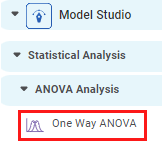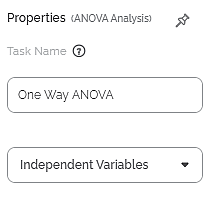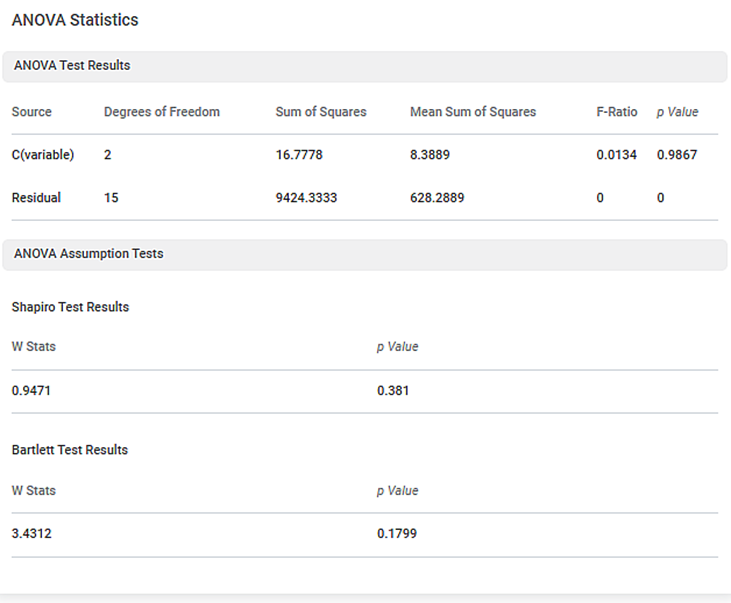One-Way ANOVA | |||||
Description | It compares the mean values of three or more independent groups in order to determine the statistical evidence that the associated population means are significantly different. | ||||
Why to use | To perform analysis of variance. | ||||
When to use | Equality testing between three or more population means. | When not to use | Equality testing between only two population means. | ||
Prerequisites | Independent variables should be numerical. | ||||
Input | Any dataset that contains numerical data. | Output |
| ||
Statistical Methods used |
| Limitations |
| ||
One Way ANOVA is located under Model Studio ( ) in ANOVA Analysis under Statistical Analysis, in the task pane on the left. Use the drag-and-drop method to use the algorithm in the canvas. Click the algorithm to view and select different properties for analysis. Refer to Properties of One-Way ANOVA.
One Way ANOVA is a statistical analysis method. It is used to determine if there are any statistical differences in three or more samples' mean values.
In One-Way ANOVA,
Null Hypothesis – All the samples have an equal mean.
Alternative Hypothesis – All the samples do not have equal means.
One-Way ANOVA tests the Null Hypothesis(H0),
H0: µ0 = µ1 = µ2 = µ3 = … = µk
Where,
µ = the group mean
k = number of samples
Suppose One-Way ANOVA returns a significant result. In that case, we accept the alternative hypothesis: at least two groups have mean values that are significantly different from each other.
However, it cannot tell which groups have significantly different means.
Properties of One-Way ANOVA
The available properties of One-Way ANOVA are as shown in the figure given below.
The table given below describes the different fields present on the properties of One-Way ANOVA.
Field | Description | Remark |
Task Name | It is the name of the task selected on the workbook canvas. | You can click the text field to edit or modify the name of the task as required. |
Independent Variables | It allows you to select the experimental or predictor variable(s). |
|
Interpretation of Result of One-Way ANOVA
The table given below describes the parameters of One-Way ANOVA Test Results.
Parameter | Description | Remark |
Degrees of Freedom | The number of independent values that can differ freely within the constraints imposed on them. | — |
Sum of Squares | It is the sum of the square of the variations. Variation is the difference (or spread) of each value from the mean. | — |
Mean Sum of Squares | It is the value obtained by diving the Sum of Squares by Degrees of Freedom. | — |
F-Ratio | It is the ratio of two Mean Square values. | If the null hypothesis is true, the value of the F-ratio is closer to 1.0 |
p Value | It is the probability of obtaining the observed results, or more extreme, of a hypothesis test, assuming that the null hypothesis of the study question is true. | If p value < 0.05, we accept the alternative hypothesis. If p value > 0.05, we do not reject the null hypothesis. |
W Stats | It tests whether a random sample comes from a normal distribution. Shapiro Wilk Test and Bartlett Test both generate this value. | If the W Stats value is small, the null hypothesis is rejected, and it can be concluded that the random sample is not normally distributed. |
Shapiro Wilk Test | Null Hypothesis – The collected samples are from a normally distributed population. Alternative Hypothesis – The collected samples are from a population that is not normally distributed. | If p value < 0.05, we accept the alternative hypothesis. If p value > 0.05, we do not reject the null hypothesis. |
Bartlett Test | Null Hypothesis – All the samples have the same variance. (They have homogeneity in variance.) Alternative Hypothesis – All the samples do not have the same variance. | If p value < 0.05, we accept the alternative hypothesis. If p value > 0.05, we do not reject the null hypothesis. |
Example of One-Way Anova
Consider an example of a manufacturing plant that uses different packaging methods. The number of products packed per minute by five different methods - A, B, C, D, and E, is given below.
We apply One-Way ANOVA on the above data. The result is displayed in the figure given below.
In the above figure,
- The p-value for ANOVA Analysis is 0.9867
- The p-value for Shapiro Wilk Test is 0.381
- The p-value for the Bartlett test is 0.1799
Since p-value of ANOVA (0.9867) is greater than 0.05, we conclude that the population is normally distributed, and all the samples have the same variance.
Table of Contents



